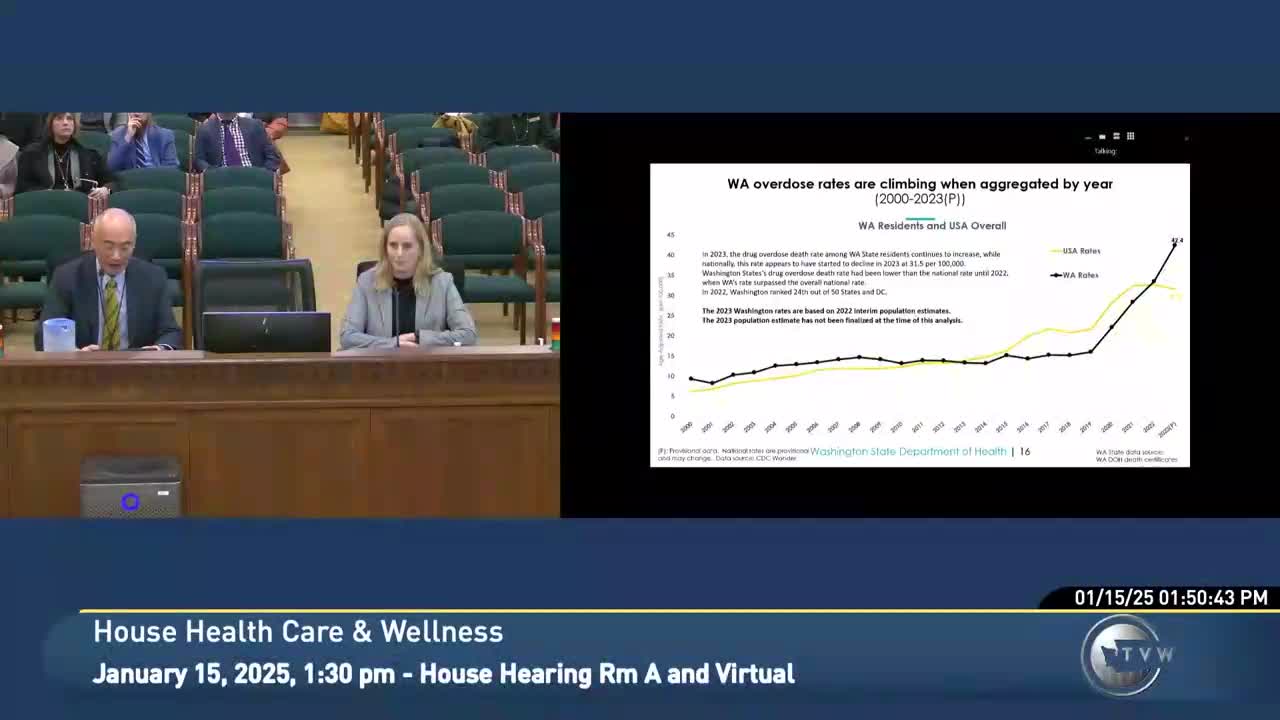Washington State confronts rising opioid overdose deaths with new treatment and prevention strategies
January 15, 2025 | Health Care & Wellness, House of Representatives, Legislative Sessions, Washington
This article was created by AI summarizing key points discussed. AI makes mistakes, so for full details and context, please refer to the video of the full meeting. Please report any errors so we can fix them. Report an error »

Washington State is intensifying its efforts to combat the opioid crisis, particularly as overdose deaths continue to rise despite a national trend of decline. During a recent meeting of the House Health Care & Wellness Committee, officials highlighted the alarming statistics surrounding opioid-related fatalities, with Washington's rates increasing while the national average appears to be plateauing.
The meeting underscored the urgent need for targeted interventions, especially in vulnerable communities. Data revealed that while King County has the highest number of overdose deaths, rural areas and specific demographics, including tribal and African American communities, are experiencing some of the highest rates of fatalities. This disparity emphasizes the necessity for a focused response to address the unique challenges faced by these populations.
One of the key strategies discussed is the state’s opioid and overdose response plan, which aims to connect individuals with opioid use disorder to effective treatments such as buprenorphine and methadone. These medications are crucial in alleviating withdrawal symptoms and preventing overdose deaths. A new pilot program allows emergency medical responders to administer buprenorphine on-site during overdose incidents, bridging the gap between emergency care and long-term treatment.
Additionally, the distribution of naloxone, a life-saving medication that can reverse opioid overdoses, is being expanded. The Department of Health is collaborating with various partners to ensure naloxone is accessible in high-risk areas, including schools and community centers. A standing order allows anyone to obtain naloxone from pharmacies without a prescription, further increasing its availability.
The meeting also emphasized the importance of accurate information and data sharing to raise awareness about the dangers of opioids, particularly among youth. The state has developed an opioid overdose dashboard to provide communities with real-time data on the crisis, helping to inform local responses and reduce stigma surrounding opioid use disorder.
As Washington State continues to grapple with the opioid epidemic, these initiatives represent a proactive approach to saving lives and supporting those affected by addiction. The commitment to improving access to treatment and resources reflects a growing recognition of the opioid crisis as a public health emergency that requires comprehensive and collaborative solutions.
The meeting underscored the urgent need for targeted interventions, especially in vulnerable communities. Data revealed that while King County has the highest number of overdose deaths, rural areas and specific demographics, including tribal and African American communities, are experiencing some of the highest rates of fatalities. This disparity emphasizes the necessity for a focused response to address the unique challenges faced by these populations.
One of the key strategies discussed is the state’s opioid and overdose response plan, which aims to connect individuals with opioid use disorder to effective treatments such as buprenorphine and methadone. These medications are crucial in alleviating withdrawal symptoms and preventing overdose deaths. A new pilot program allows emergency medical responders to administer buprenorphine on-site during overdose incidents, bridging the gap between emergency care and long-term treatment.
Additionally, the distribution of naloxone, a life-saving medication that can reverse opioid overdoses, is being expanded. The Department of Health is collaborating with various partners to ensure naloxone is accessible in high-risk areas, including schools and community centers. A standing order allows anyone to obtain naloxone from pharmacies without a prescription, further increasing its availability.
The meeting also emphasized the importance of accurate information and data sharing to raise awareness about the dangers of opioids, particularly among youth. The state has developed an opioid overdose dashboard to provide communities with real-time data on the crisis, helping to inform local responses and reduce stigma surrounding opioid use disorder.
As Washington State continues to grapple with the opioid epidemic, these initiatives represent a proactive approach to saving lives and supporting those affected by addiction. The commitment to improving access to treatment and resources reflects a growing recognition of the opioid crisis as a public health emergency that requires comprehensive and collaborative solutions.
View full meeting
This article is based on a recent meeting—watch the full video and explore the complete transcript for deeper insights into the discussion.
View full meeting
